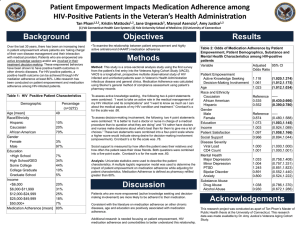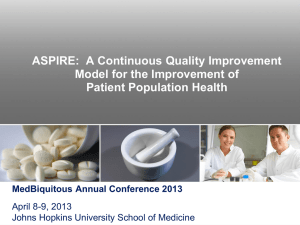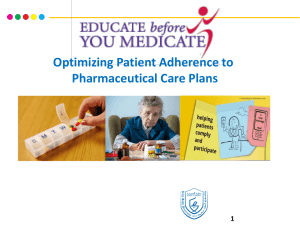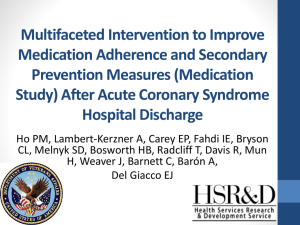Patients Medication Adherence in Chronic Diseases in Zagreb
advertisement
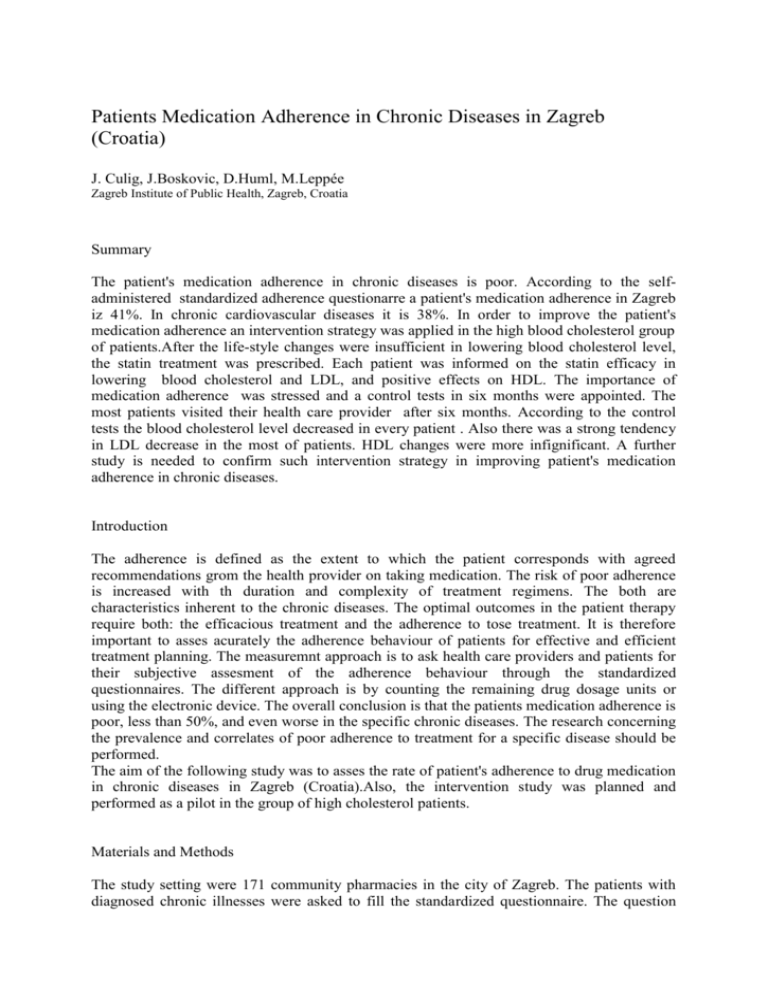
Patients Medication Adherence in Chronic Diseases in Zagreb (Croatia) J. Culig, J.Boskovic, D.Huml, M.Leppée Zagreb Institute of Public Health, Zagreb, Croatia Summary The patient's medication adherence in chronic diseases is poor. According to the selfadministered standardized adherence questionarre a patient's medication adherence in Zagreb iz 41%. In chronic cardiovascular diseases it is 38%. In order to improve the patient's medication adherence an intervention strategy was applied in the high blood cholesterol group of patients.After the life-style changes were insufficient in lowering blood cholesterol level, the statin treatment was prescribed. Each patient was informed on the statin efficacy in lowering blood cholesterol and LDL, and positive effects on HDL. The importance of medication adherence was stressed and a control tests in six months were appointed. The most patients visited their health care provider after six months. According to the control tests the blood cholesterol level decreased in every patient . Also there was a strong tendency in LDL decrease in the most of patients. HDL changes were more infignificant. A further study is needed to confirm such intervention strategy in improving patient's medication adherence in chronic diseases. Introduction The adherence is defined as the extent to which the patient corresponds with agreed recommendations grom the health provider on taking medication. The risk of poor adherence is increased with th duration and complexity of treatment regimens. The both are characteristics inherent to the chronic diseases. The optimal outcomes in the patient therapy require both: the efficacious treatment and the adherence to tose treatment. It is therefore important to asses acurately the adherence behaviour of patients for effective and efficient treatment planning. The measuremnt approach is to ask health care providers and patients for their subjective assesment of the adherence behaviour through the standardized questionnaires. The different approach is by counting the remaining drug dosage units or using the electronic device. The overall conclusion is that the patients medication adherence is poor, less than 50%, and even worse in the specific chronic diseases. The research concerning the prevalence and correlates of poor adherence to treatment for a specific disease should be performed. The aim of the following study was to asses the rate of patient's adherence to drug medication in chronic diseases in Zagreb (Croatia).Also, the intervention study was planned and performed as a pilot in the group of high cholesterol patients. Materials and Methods The study setting were 171 community pharmacies in the city of Zagreb. The patients with diagnosed chronic illnesses were asked to fill the standardized questionnaire. The question concerned the reasons for not taking prescribed medications. The questionnaire was modifed ACTG Adherence Baseline Questionnaire. Total number of patients accepted to fill the questionnare was 634, 258 males and 376 females. The number of retired patients was 356 (56% of total) and the number of university degree patients was 237 (37 %). Most of them (458 /634) acquired cardiovascular chronic diseases and had prescribed relevant drug medications. The intervention substudy included the 85 high cholesterol patients with prescribed statins treatment in the equivalent pharmacological dosage schedules. They were divided into two groups between the two healthcare teams. The life-styles changes ( diet, exercise) was recommended to each patient. Three months later the blood test were done and total cholesterol, HDL and LDL determined. The results were shown to the patients, the statins were prescribed and the goal of treatment explained to each. Six months later the blood tests were repeated. Results The analysis of 634 questionnaires has shown the rate of 41% patients adherence to the prescribed medication. The patients adherence rate in cardiovascular chronic diseases was slightly lower (38 %). The statin intervention group consisted of 35 males ( average age 56,8 years) and 50 females ( average age 64,1 years).After the six months of statin treatment the blood cholesterol level in the males group decreased in average for 2,18 µmol/l, and in the females group it decreased in average for 2,57 (Figure 1). LDL decreased for 1,26 in average in the females, and 0,54 in the males. HDL increased for 0,12 in the females in average, but decreased in the males for 0,13 in average. The influence of age was analysed comparing the two different age groups ( 0-64 and 65+ ). The level of total blood cholesterol in the younger dropped in average for 1,86 and in the elderly for 1,74 in average. The number of total drug medication has been marked as factor of poor adherence. We divided patients in the two groups: one that was taking 1-3 different drugs included the statins, ane second with 4+ drugs prescribed. The blood cholesterol level decreased more profoundly in the group with less medication ( 2,11/1,64). The patients were also analysed according to the main chronic disease diagnosed. For the purpose of analysis they were divided into two main categories: the group of hyperlipidaemias and the group of ischaemic cardiac diseases. In the hiperlipidaemia patients blood cholesterol decreased in average 2,63 µmol/l and LDL decreased in average 1,11. In the ischaemic heart disease patients decrease of blood cholesterol was 1,61 in average and LDL decreased 1,02 in average. The results have shown shown a positive influence on the patients medication adherence behaviour by informing them how the statin treatment adherence could be assesed by measuring blood cholesterol, HDL and LDL. It is claimed that the personality variables do not influence a medication adherence significantly. However, in our small pilot study there were tendencies toward better results in the females, the younger and less complex drug treatment. Such strategies may be used to improve the patient's medication adherence. 8 7 milimol/L 6 5 4 3 2 1 0 Cholesterol level after lyfe-style changes (3 months) Male Cholesterol level(6 months after) Female Figure 1. A blood cholesterol level in the statins prescribed patients Conclusions The patient's medication adherence in chronic diseases in Zagreb is poor. The chronic diseases are permanent, leave residual disability, require special training of the patient for rehabilitaton and long duration medication. The adherence is the most important factor that compromises treatment outcome. The patients need advice, support and information from health proffesionals to be able to understand the importance of adherence to chronic drug medication. The interventions to improve adherence to medication were more effective when they included multiple-components such as more convenient care, information, counselling, reminders, self-monitoring, reinforcement or family therapy. Different strategies to improve patient's adherence are in use. The health providers ( MD and pharmacist) have improved their communications skills. They provide information, use „poitive talk“ technique, motivate and asking patients specific questions about adherence. Patient's personality variables have not emerged as significant predictors. Illness- relevant cognitions, perception of disease factors and beliefs about treatment have stronger relationship to adherence. A specific intervention strategies to improve patient's medication adherence should be applied in chronic diseases. They should be based on patient education, specific knowledge, beliefs, motivations and actions. References Wilson MG, Edmundson J : Characteristic of adherers of a worksite cholesterol programme. Health Values, 1993,17:10-20. Huml D,Stimac D,Culig J, Andabaka I,Tadic I, Portolan M: Improving patient's medication adherence in chronic diseases. 37th ESCP Symposium, Dubrovnik, Croatia, 21-24 October 2008. Abstract Book, p 90. Stimac D, Culig J, Sostar Z, Bucalic M.: Cardiovascular Drug Prescribing in Croatia 20012005. Pharmacoepidemiology and Safety 2007; 16 ,Suppl 2, P274.


